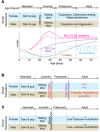Long-Term Behavioral Effects of Post-weaning Social Isolation in Males and Females
- PMID: 31031604
- PMCID: PMC6470390
- DOI: 10.3389/fnbeh.2019.00066
Long-Term Behavioral Effects of Post-weaning Social Isolation in Males and Females
Abstract
Adolescence is a developmental period associated with vast neural and behavioral changes which are accompanied by altered sensitivity to stimuli, both stressful and rewarding. Perturbations, especially stressful stimuli, during this period have been shown to alter behavior in adulthood. Social isolation rearing is one such perturbation. This review highlights the long-term behavioral consequences of adolescent social isolation rearing in rodents with a specific focus on anxiety- and addiction-related behaviors. Sex-specific effects are discussed where data are available. We then consider changes in monoaminergic neurotransmission as one possible mechanism for the behavioral effects described. This research on both normative and perturbed adolescent development is crucial to understanding and treating the increased vulnerability to psychiatric disorders seen in humans during this life stage.
Keywords: addiction; adolescence; anxiety; depression; dopamine; isolation rearing; reward; serotonin.
Figures



Similar articles
-
Long-Term Impacts of Post-weaning Social Isolation on Nucleus Accumbens Function.Front Psychiatry. 2021 Sep 20;12:745406. doi: 10.3389/fpsyt.2021.745406. eCollection 2021. Front Psychiatry. 2021. PMID: 34616326 Free PMC article. Review.
-
Consequences of post-weaning social isolation on anxiety behavior and related neural circuits in rodents.Front Behav Neurosci. 2009 Aug 20;3:18. doi: 10.3389/neuro.08.018.2009. eCollection 2009. Front Behav Neurosci. 2009. PMID: 19738931 Free PMC article.
-
Behavioral alterations induced by post-weaning isolation rearing of rats are accompanied by reduced VGF/BDNF/TrkB signaling in the hippocampus.Neurochem Int. 2019 Oct;129:104473. doi: 10.1016/j.neuint.2019.104473. Epub 2019 May 23. Neurochem Int. 2019. PMID: 31128132
-
Short post-weaning social isolation induces long-term changes in the dopaminergic system and increases susceptibility to psychostimulants in female rats.Int J Dev Neurosci. 2017 Oct;61:21-30. doi: 10.1016/j.ijdevneu.2017.05.003. Epub 2017 May 27. Int J Dev Neurosci. 2017. PMID: 28559209
-
Adolescence and Reward: Making Sense of Neural and Behavioral Changes Amid the Chaos.J Neurosci. 2017 Nov 8;37(45):10855-10866. doi: 10.1523/JNEUROSCI.1834-17.2017. J Neurosci. 2017. PMID: 29118215 Free PMC article. Review.
Cited by
-
Crystallin Mu in Medial Amygdala Mediates the Effect of Social Experience on Cocaine Seeking in Males but Not in Females.Biol Psychiatry. 2022 Dec 1;92(11):895-906. doi: 10.1016/j.biopsych.2022.06.026. Epub 2022 Jun 30. Biol Psychiatry. 2022. PMID: 36182529 Free PMC article.
-
Comparison of the effect of postweaning social isolation, enriched environment, and exercise training on learning and memory functions in rats.Turk J Med Sci. 2023 Jun 21;53(5):1412-1420. doi: 10.55730/1300-0144.5708. eCollection 2023. Turk J Med Sci. 2023. PMID: 38812994 Free PMC article.
-
Long-Term Impacts of Post-weaning Social Isolation on Nucleus Accumbens Function.Front Psychiatry. 2021 Sep 20;12:745406. doi: 10.3389/fpsyt.2021.745406. eCollection 2021. Front Psychiatry. 2021. PMID: 34616326 Free PMC article. Review.
-
Animal Models of Depression: What Can They Teach Us about the Human Disease?Diagnostics (Basel). 2021 Jan 14;11(1):123. doi: 10.3390/diagnostics11010123. Diagnostics (Basel). 2021. PMID: 33466814 Free PMC article. Review.
-
Juvenile social isolation in Sprague Dawley rats does not have a lasting impact on social behavior in adulthood.Sci Rep. 2025 Apr 15;15(1):12981. doi: 10.1038/s41598-025-95920-z. Sci Rep. 2025. PMID: 40234569 Free PMC article.
References
-
- Archer J. (1969). Contrasting effects of group housing and isolation on subsequent open field exploration in laboratory rats. Psychonomic. Sci. 14, 234–235. 10.3758/BF03332812 - DOI
Grants and funding
LinkOut - more resources
Full Text Sources

